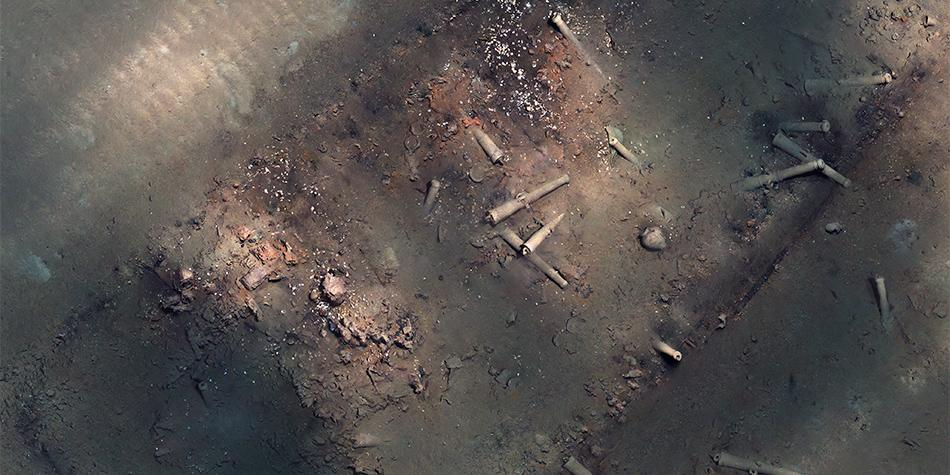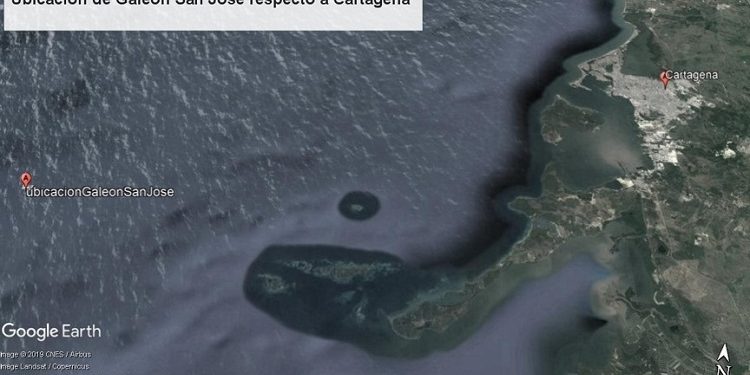Update: July 18th, 2023. Reading time: 7 min.
The most recent discovery of the San Jose Galleon shipwreck was made public in November 2015, after joint missions between the Colombian Institute of Anthropology and History (ICAHN), the Colombian General Maritime Directorate (DIMAR), specialists from the MAC (Maritime Archaeology Consultants) and technicians from the Woods Hole Oceanographic Institution-WHOI using the Colombian Navy oceanographic vessel “ARC Malpelo”. In the following image, you can see how far the research area is.
Underwater surprise
After exploring an area of 500,000 m2 at 600 m depth in the Caribbean Sea, the shipwreck of the Spanish Galleon San Jose was found, which was sunk by the British navy in the 18th century near Cartagena de Indias.

How was the shipwreck located? How those were taken images? What technology was used?
For the exploration of the 500,000 m2, a SIDE-SCAN SONAR was used, which was on board the AUTONOMOUS UNDERWATER VEHICLE (AUV) REMUS 6000 supplied by WHOI. With this device, high-resolution images were generated, which facilitated the detection of areas with traces of the shipwreck due to the presence of anomalies on the seabed.
A side-scan sonar is an acoustic system used to generate high-resolution images of the seafloor through the emission of high-frequency sound pulses.
An Autonomous Underwater Vehicle (AUV) is a submarine-type vehicle capable of navigating and following trajectories without human intervention. Some existing models can even make decisions as complex as the life or death of an invasive species such as the Crown-of-Thorns Starfish in Australia (COTSbot, and RangerBot).

A subsequent mission included a SUB-BOTTOM PROFILING SYSTEM and a MULTI-BEAM SONAR to explore the regions of high interest identified above and to generate a three-dimensional reconstruction of the area. The former allows the detection of irregularities in the seabed, and the latter facilitates the three-dimensional reconstruction of a specific area from the emission of various ultrasound signals. Additionally, it was necessary to use a magnetometer, better known as a metal detector.
Thus, the finding of various irregularities led to a deeper analysis of that particular area with higher resolution sonar scans and a more detailed photographic record. In this way, it was possible to identify archaeological artifacts belonging to the shipwreck of the San Jose Galleon.

What’s next for the San Jose Galleon?
All the information collected using underwater technology has served to establish the requirements for a future stage of intervention and recovery of the San Jose Galleon. According to the Public-Private Association, at this stage, an archaeological methodology should be used to fully register the site, guaranteeing an adequate procedure for the registration of each of the objects to be recovered.
For the intervention phase, to recover the archaeological heritage, the MAC company proposes to use a platform on the seabed that will serve as a support to operate an ROV (Remotely Operated Vehicle) while removing the sediment with the injection of air jets; All this at 600 m depth and operated from a vessel! They also propose to use a suction system for these sediments to expose the objects, which will be extracted and transferred to containers by another ROV equipped with high-precision robotic arms. Then the containers will be brought to the surface. These tasks should be carried with high precision and caution to not affect the pieces found, for this reason, it will take several months to complete.

All the technology necessary for the stages of identification and intervention of archaeological sites, as is the case of the San Jose Galleon, is commercially available and is mainly operated by different companies around the world. However, it is important to highlight that in our country, technical capacities and experience have been building up in the development and operation of underwater technology of this type, through different research projects in universities, initiatives of non-profit organizations and, technology-based ventures (like DeepCo!).
It is noteworthy that San Jose Galleon represents a technological and technical challenge for the country. Therefore, it is essential to involve archaeologists, oceanographers, geologists, engineers, among other experts, and concentrate efforts on the integration of knowledge for decision-making purposes. As a result, it will be possible to recover, preserve, and divulge, not only this invaluable piece of our cultural heritage but also all the richness that can be found in the underwater environments of our territory.
In a future publication, you will learn more about Remotely Operated Vehicles ROV. Follow us and learn more about Underwater Technology.

